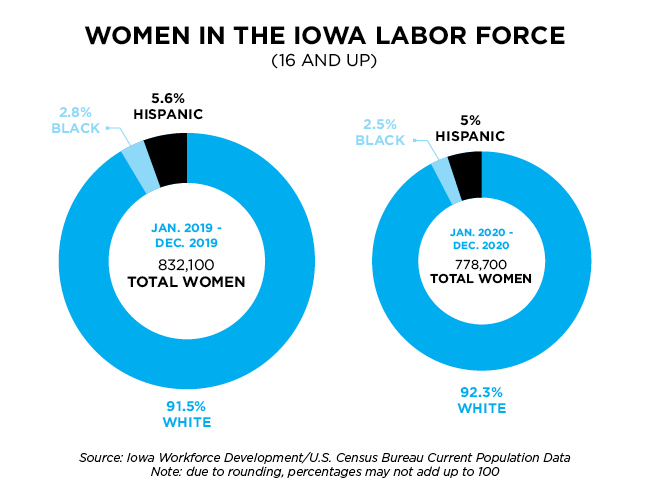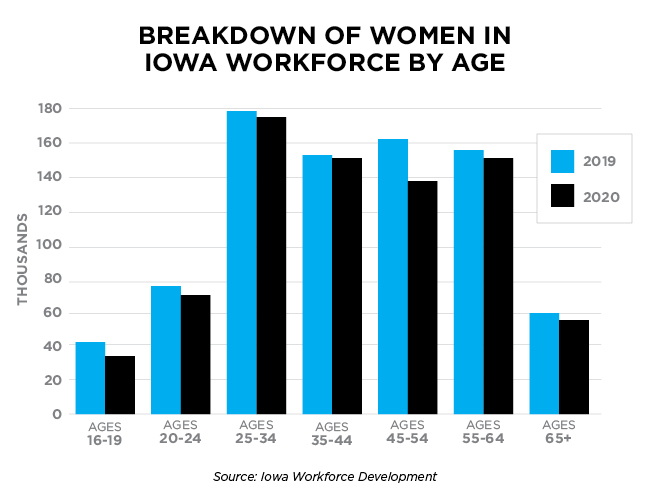By Emily Blobaum, Fearless editor
Editor’s note: This article is a continuation of the Business Record’s 2021 women’s and gender survey results. We recognize that there are many opinions and ideas around this topic, but for the purpose of this story, we’re only including ideas detailed in the survey responses. If you have your own ideas that you don’t see mentioned here and would like to submit a contributed piece, please reach out to emilyblobaum@bpcdm.com.
At the start of 2020, women held the majority of American jobs for the first time in nearly a decade, thanks to job gains in service sectors. In Iowa, 832,100 women aged 16 and up held jobs in 2019, making up just under 50% of the state’s workforce.
Then March 2020 arrived. COVID-19 restrictions decimated hospitality, retail, government and care industries – all of which had majority or near-majority women making up the workforce. Many day care facilities and schools were forced to close their doors, leaving women to shoulder the responsibility of child care. Within a year, more than 2.3 million women nationally – 53,400 of them in Iowa – dropped out of the labor force.
Job losses have also disproportionately affected women of color. In February 2021, employment for Black and Hispanic women nationwide was 9.7% and 8.6% lower, respectively, than it was in February 2020, compared with 5% for white women.


Now, as businesses and cities across the country and in Iowa are in the process of reopening, leaders in the private and public sectors have made one thing clear: The economy won’t fully recover unless women can fully participate.
Therein lies the million-dollar question: What needs to be done to ensure that the post-pandemic recovery is equitable for all, especially women?
We asked a similar question in our annual women’s survey earlier this year. About 130 people responded with different ideas, and we talked with Dawn Oliver Wiand, executive director of the Iowa Women’s Foundation, and Amanda Young, chief human resources officer at Bankers Trust, to help contextualize answers.
“Before [the pandemic], we had a workforce shortage and we had a child care shortage, and we truly believe they’re interrelated,” Oliver Wiand said. “If we have a workforce shortage, we’re going to have to figure out how to get more women back in. And we can do that with family-friendly policies, quality, affordable child care, and work flexibility. It’s going to be essential if we want our businesses and our state to be able to recover and continue to grow.”
Flexibility
More than 45% of our survey respondents mentioned that flexible work policies were a must.
“It is critical that companies offer flexibility in work schedules. This has a direct benefit to women, who tend to be the primary caretakers at home.”
“As the pandemic lifts, enable as much flexibility as possible regarding where, when and how women work – as long as the work is getting done. Encourage businesses to form collaborations with other businesses to offer discounted day care to their employees.”
“If you give women the flexibility to make their work match their life (vs. rearranging their life to manage their work,) you will not only have a better work product but a more loyal employee that feels empowered and appreciated.”
“Women – and men – need flexibility. Companies need to value workers’ families as much as they value the bottom line. As a manager, I have found that if employees are content outside of work, they’re more productive and engaged at work.”
Both Young and Oliver Wiand agree.
Young: “I think there has to be a concentration on flexible schedules and work arrangements and realizing that everybody has a different situation.”
Oliver Wiand: “Flexibility not only gives the family different options, but it gives businesses and communities different options. You don’t have to do something just because that’s how it’s always been done.”
Child care and family leave
Nearly 50% of survey responses discussed the need for better child care.
“Offering affordable child care is a necessity, along with quality family leave.”
“Offer on-site child care or a child care subsidy.”
“Extend maternity leave, provide paid leave when needing to take time off to care for dependents.”
“No penalties for sick days due to child care issues.”
“Allow more infants in the workplace.”
“If we don’t get the child care situation fixed, women won’t be coming back to work,” Oliver Wiand said matter-of-factly. “Child care is a core economic issue and an essential workforce support. Without it, there will be no economic recovery for Iowa’s families, businesses or communities.”
Child care availability, affordability and quality has been a major issue in Iowa. Nearly a quarter of the state’s population lives in a child care desert, and on average, it costs more to send your kid to a child care facility than it does to pay tuition at any of Iowa’s regent universities.
The Iowa Women’s Foundation recently published a toolkit for Iowa businesses that details child care solutions, some of which include flexible spending accounts, subsidized child care, on-site child care and backup child care.
As for family leave, the U.S. is the only industrialized country that doesn’t nationally mandate paid parental leave. The Family and Medical Leave Act requires workplaces with 50 or more people to offer 12 weeks of unpaid, job-protected leave to employees who have worked at that business for more than a year, and about 40% of workers aren’t covered. Furthermore, only 20% of private-sector workers had access to paid family leave through their employers in 2020.
Final thoughts
“Stop treating us like we’re lesser. Stop treating pregnancy like it’s a problem. Stop treating care jobs and support staff as expendable. Stop allowing such a wide gap of gendered jobs. Stop ignoring toxic masculinity.”
“Take ownership and accountability for inequities. Recognize the extra burdens that are placed on women at home and in the workplace when setting policies and work schedules. Expect privileged men to step up and contribute to things that are heavily relied on women to do.”
“We need greater safety nets for people who lose their jobs. They are in most cases hard workers who are suffering through no fault of their own.”
“I don’t believe it is the companies’ responsibility. Ultimately, employment by an individual is up to that person and what works best for their family. Maybe some individuals chose to leave the workforce. The government should do what they can to encourage women to get back into the workforce and companies should do what they have always done, hire applicants based on qualifications.”
“Long term, companies need to be intentional in their leadership development opportunities for women. When households are weighing the decision for one partner to stay home, the partner with the lower earning potential will be the one to stay home. As long as we continue to see lower female representation in leadership positions, the male will continue to be the higher income earner, generally speaking.”
Young emphasized that if companies want to put infrastructures in place that address equity gaps – and will stand the test of time – it’s important to be intentional about surveying employees.
“Doing anything in a bubble – whether it’s your leadership team or HR team – isn’t a good strategy.”


